With more winter sports gear going high-tech — and mingling with the gear we carry day to day — we’ve annually produced a roundup of high-tech ski gear. While some products from last year’s roundup have carried over, we’ve updated the list with several new products for 2022.
Much of the gear in the roundup is battery-powered, though not everything has a power component to it. In some cases, we’ve included items that have high-tech materials or cutting-edge designs.

 \n ","topic":"","ttag":"","variant":"","viewguid":"","event":"listicle|image|1","correlationId":"","_destCat":"https:\/\/gopro.com\/en\/us\/shop\/cameras\/hero10-black\/CHDHX-101-master.html?option-id=CHDHX-101-master","productName":"GoPro Hero 10 Black","formatType":"IMAGE","location":"LIST","position":1,"sku":"","dwLinkTag":"article-body|listicle|image","selector":"#article-body #listicle-06de8e79-38d1-41e8-b1b8-4513b108be5a .itemImage"}}” rel=”noopener nofollow” target=”_blank”>
\n ","topic":"","ttag":"","variant":"","viewguid":"","event":"listicle|image|1","correlationId":"","_destCat":"https:\/\/gopro.com\/en\/us\/shop\/cameras\/hero10-black\/CHDHX-101-master.html?option-id=CHDHX-101-master","productName":"GoPro Hero 10 Black","formatType":"IMAGE","location":"LIST","position":1,"sku":"","dwLinkTag":"article-body|listicle|image","selector":"#article-body #listicle-06de8e79-38d1-41e8-b1b8-4513b108be5a .itemImage"}}” rel=”noopener nofollow” target=”_blank”>


Josh Goldman/CNET
At the moment, the GoPro Hero10 is the best single-lens action camera you can get from GoPro. It’s not a big upgrade over the GoProHero 9, which is available for a little less, but it has a new GP2 chip that allows high resolutions at higher frame rates — up to 5.3K (5,312 x2,988 pixels) at 30 or 60 frames per second. It also has HyperSmooth 4.0, GoPro’s highest level of image stabilization.
As with the Hero 9 Black, pricing is a little confusing for the Hero 10 Black. The camera is $499, which is $50 more than the Hero 9’s starting price. However, if you buy directly from GoPro.com and sign up for the GoPro subscription service — which is included with the camera — GoPro knocks $100 off, so it’s $399 (a year of the service, which costs $50 a year or $5 a month, is included for free).
The subscription service gives you unlimited cloud backups at original quality, damaged camera replacement, discounts on GoPro accessories and gear and access to GoPro’s premium live streaming platform.

 \n ","topic":"","ttag":"","variant":"","viewguid":"","event":"listicle|image|2","correlationId":"","_destCat":"https:\/\/store.insta360.com\/product\/one_x2","productName":"Insta360 One X2","formatType":"IMAGE","location":"LIST","position":2,"sku":"","dwLinkTag":"article-body|listicle|image","selector":"#article-body #listicle-9f44bcb8-8f8d-44ff-bf29-14c268012199 .itemImage"}}” rel=”noopener nofollow” target=”_blank”>
\n ","topic":"","ttag":"","variant":"","viewguid":"","event":"listicle|image|2","correlationId":"","_destCat":"https:\/\/store.insta360.com\/product\/one_x2","productName":"Insta360 One X2","formatType":"IMAGE","location":"LIST","position":2,"sku":"","dwLinkTag":"article-body|listicle|image","selector":"#article-body #listicle-9f44bcb8-8f8d-44ff-bf29-14c268012199 .itemImage"}}” rel=”noopener nofollow” target=”_blank”>


David Carnoy/CNET
360 cams capture everything in a sphere around the camera, then later you can decide what you want to show — and exactly how it’s shown. For this type of camera, a lot of people like the GoPro Max, which is selling for around $430, but Insta360’s One X2 is also impressive and some people prefer it to the GoPro.
Insta360 sells the newer and more affordable Go 2 ($300) and the earlier One R. The Snow Bundle includes a variety of mounts and accessories, everything from a chest mount to GoPro-style helmet mounts along with a pole mount.
We have a couple of videos to give you an idea of the kind of footage Insta360 cams can produce. Former CNET Senior Video Producer Nic Henry reviewed both the Go 2 (you can find the video here) and the One X2 (you can find that video here).
Read more: Insta360 Go 2 hands-on

 \n ","topic":"","ttag":"","variant":"","viewguid":"","event":"listicle|image|3","correlationId":"","_destCat":"https:\/\/gopro.com\/en\/us\/shop\/cameras\/hero8-black\/CHDHX-801-master.html","productName":"GoPro Hero 8 Black","formatType":"IMAGE","location":"LIST","position":3,"sku":"","dwLinkTag":"article-body|listicle|image","selector":"#article-body #listicle-695bab16-c2d1-4b7a-8879-21f023991f8c .itemImage"}}” rel=”noopener nofollow” target=”_blank”>
\n ","topic":"","ttag":"","variant":"","viewguid":"","event":"listicle|image|3","correlationId":"","_destCat":"https:\/\/gopro.com\/en\/us\/shop\/cameras\/hero8-black\/CHDHX-801-master.html","productName":"GoPro Hero 8 Black","formatType":"IMAGE","location":"LIST","position":3,"sku":"","dwLinkTag":"article-body|listicle|image","selector":"#article-body #listicle-695bab16-c2d1-4b7a-8879-21f023991f8c .itemImage"}}” rel=”noopener nofollow” target=”_blank”>


Joshua Goldman/CNET
We could have put the GoPro Hero 9 Black on this list. It costs $50 less than the Hero 10 Black, but the truth is, if you’re considering the Hero 9, you might as well get the Hero 10. However, If you can do without that top-end resolution and front-facing screen, the older Hero 8 offers a decent amount of savings and remains a good choice. It still does 4K video at 60 fps, so it’s no slouch and has come down from its original list price of $350 (it’s now around $280). It was a CNET Editors’ Choice Award winner two years ago.
Read more: Best action cams

 \n ","topic":"","ttag":"","variant":"","viewguid":"","event":"listicle|image|4","correlationId":"","_destCat":"https:\/\/www.amazon.com\/ALECK-006TM-Universal-Bluetooth-Communication\/dp\/B09CG8QMM9","productName":"Aleck 006","formatType":"IMAGE","location":"LIST","position":4,"sku":"","dwLinkTag":"article-body|listicle|image","selector":"#article-body #listicle-555bc030-ed8b-41d8-8fa4-25648c7cb080 .itemImage"}}” rel=”noopener nofollow” target=”_blank”>
\n ","topic":"","ttag":"","variant":"","viewguid":"","event":"listicle|image|4","correlationId":"","_destCat":"https:\/\/www.amazon.com\/ALECK-006TM-Universal-Bluetooth-Communication\/dp\/B09CG8QMM9","productName":"Aleck 006","formatType":"IMAGE","location":"LIST","position":4,"sku":"","dwLinkTag":"article-body|listicle|image","selector":"#article-body #listicle-555bc030-ed8b-41d8-8fa4-25648c7cb080 .itemImage"}}” rel=”noopener nofollow” target=”_blank”>


David Carnoy/CNET
The Aleck 006 earpieces slip into your helmet and can be used as wireless headphones for listening to music or as a headset for making calls. They offer decent sound but what makes them even more useful is if you link multiple Aleck 006 together and set up what amounts to a walkie-talkie system among friends or family members.
With real-time GPS tracking in the Aleck Go app for iOS and Android, you can also map the location of everyone in your party.

 \n ","topic":"","ttag":"","variant":"","viewguid":"","event":"listicle|image|5","correlationId":"","_destCat":"https:\/\/www.backcountry.com\/helly-hansen-elevation-infinity-shell-jacket-mens","productName":"Helly Hansen Elevation Infinity 2.0","formatType":"IMAGE","location":"LIST","position":5,"sku":"","dwLinkTag":"article-body|listicle|image","selector":"#article-body #listicle-c20a2e10-b347-4336-a9f2-13c4187ffdb7 .itemImage"}}” rel=”noopener nofollow” target=”_blank”>
\n ","topic":"","ttag":"","variant":"","viewguid":"","event":"listicle|image|5","correlationId":"","_destCat":"https:\/\/www.backcountry.com\/helly-hansen-elevation-infinity-shell-jacket-mens","productName":"Helly Hansen Elevation Infinity 2.0","formatType":"IMAGE","location":"LIST","position":5,"sku":"","dwLinkTag":"article-body|listicle|image","selector":"#article-body #listicle-c20a2e10-b347-4336-a9f2-13c4187ffdb7 .itemImage"}}” rel=”noopener nofollow” target=”_blank”>
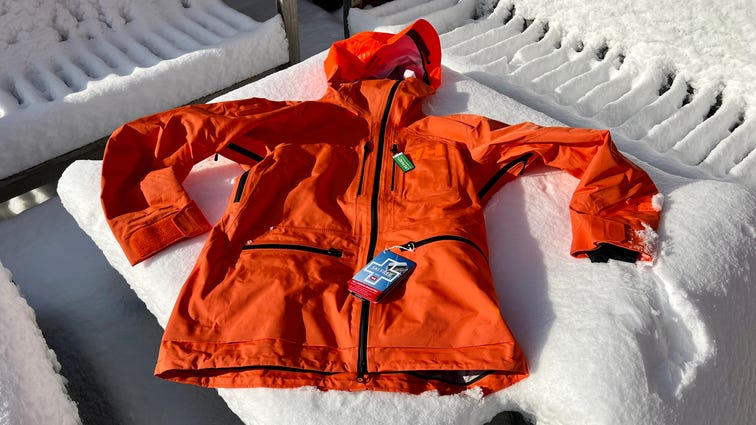

David Carnoy/CNET
Helly Hansen’s flagship $750 Elevation Infinity 2.0 technical shell jacket features the company’s LIFA Infinity Pro technology, its new waterproof, windproof yet breathable material that it says is the “first to-market to be made entirely without added chemicals.” Typically, waterproof jackets are chemically treated, but Helly Hansen says the Infinity’s “everlasting water-repellent protection never needs to be reproofed with chemical treatment after use.”
For a shell jacket it offers good flexibility and doesn’t feel stiff. While it has a three-layer fabric construction and offers some warmth, it’s not insulated so in very cold conditions you’d need to wear another jacket underneath it, like the Odin Lifaloft Hybrid ($400).
The Elevation Infinity 2.0 comes in black, gray fog and orange (pictured) and, like other premium Helly ski jackets, also features its Life Pocket Plus, which uses Aerogel insulation to help keep your phone from getting too cold, thus preserving its battery.

 \n ","topic":"","ttag":"","variant":"","viewguid":"","event":"listicle|image|6","correlationId":"","_destCat":"https:\/\/www.amazon.com\/Giro-Spherical-Helmet-Integrated-Shield\/dp\/B08FNZQKJF","productName":"Giro Orbit (Aria for women)","formatType":"IMAGE","location":"LIST","position":6,"sku":"","dwLinkTag":"article-body|listicle|image","selector":"#article-body #listicle-28712ba0-81b9-46dc-b252-108a632ef05c .itemImage"}}” rel=”noopener nofollow” target=”_blank”>
\n ","topic":"","ttag":"","variant":"","viewguid":"","event":"listicle|image|6","correlationId":"","_destCat":"https:\/\/www.amazon.com\/Giro-Spherical-Helmet-Integrated-Shield\/dp\/B08FNZQKJF","productName":"Giro Orbit (Aria for women)","formatType":"IMAGE","location":"LIST","position":6,"sku":"","dwLinkTag":"article-body|listicle|image","selector":"#article-body #listicle-28712ba0-81b9-46dc-b252-108a632ef05c .itemImage"}}” rel=”noopener nofollow” target=”_blank”>


David Carnoy/CNET
Helmets with integrated lens shields or goggles have become popular in Europe in recent years and Giro makes one of the best ones with its Orbit helmet that also comes in a version for women called the Aria (it looks very similar but has different colored trim elements). While these types of helmets tend to be expensive, they’re good for people who wear glasses or just like the convenience of eye protection integrated into a helmet design — you can rotate the articulating “shield” up onto the helmet or tilt it down over your face. It’s also worth noting that the large Vivid lens (with optics by Zeiss) provides a very wide field of view.
Unlike some shields that have an open design at the bottom, this one has a foam liner and is designed to sit on your face like goggles, though the seal isn’t quite as tight as a typical pair of goggles. There’s good ventilation and the helmet is very comfortable to wear, with a Polartec “Power Grid” padded lining that helps with moisture management. Like many of Giro’s helmets, this one also incorporates the company’s custom Spherical MIPS (Multi-directional Impact Protection) technology.
The included lens shield is designed to work well in a variety of conditions (it is replaceable for $125). It does a a very good job staying fog-free on non-storm days, but I can’t guarantee that it won’t fog at times on big snow days, which can challenging for most goggles (particularly if you wear glasses or prescription lens inserts with your goggles). That said, it’s an excellent helmet overall.

 \n ","topic":"","ttag":"","variant":"","viewguid":"","event":"listicle|image|7","correlationId":"","_destCat":"https:\/\/www.backcountry.com\/spy-marauder-elite-goggles","productName":"Spy Marauder Elite","formatType":"IMAGE","location":"LIST","position":7,"sku":"","dwLinkTag":"article-body|listicle|image","selector":"#article-body #listicle-4ee92a24-7ba8-4ce3-97e0-220c97852be2 .itemImage"}}” rel=”noopener nofollow” target=”_blank”>
\n ","topic":"","ttag":"","variant":"","viewguid":"","event":"listicle|image|7","correlationId":"","_destCat":"https:\/\/www.backcountry.com\/spy-marauder-elite-goggles","productName":"Spy Marauder Elite","formatType":"IMAGE","location":"LIST","position":7,"sku":"","dwLinkTag":"article-body|listicle|image","selector":"#article-body #listicle-4ee92a24-7ba8-4ce3-97e0-220c97852be2 .itemImage"}}” rel=”noopener nofollow” target=”_blank”>
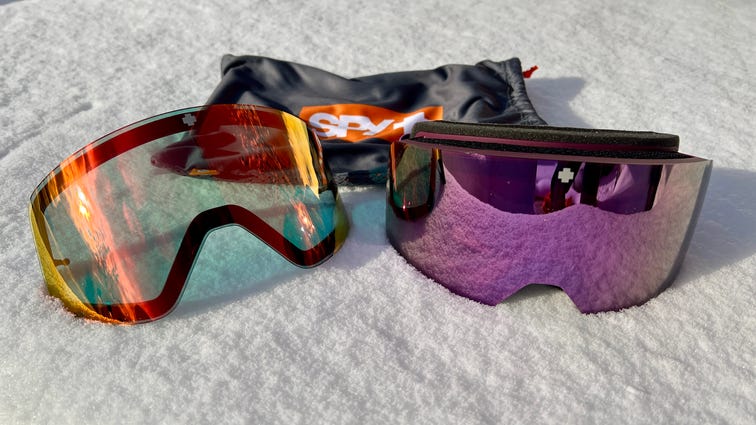

David Carnoy/CNET
The Marauder Elite is Spy’s latest and greatest model of goggles that features 60% more venting over the similarly styled Spy Ace goggles (another highly vented model). That makes it “nearly impossible to fog,” according to the company. They didn’t fog on me during my limited testing, but I still need to put them through a wider variety of conditions to confirm that.
The goggles’ lenses adhere magnetically and can be easily swapped out (two lenses are included). These are over-the-glasses (OTG) type that are suitable for use with RX eyeglasses and have subtle notches in the temples to allow your glasses to fit better. Like Spy’s other premium goggles, these feature the company’s Happy lens tech, which it says is “scientifically tuned to boost mood and alertness while optimizing color and contrast.”
They’re a nice pair of goggles and although they’re expensive, Spy has been having trouble keeping them in stock.

 \n ","topic":"","ttag":"","variant":"","viewguid":"","event":"listicle|image|8","correlationId":"","_destCat":"https:\/\/www.amazon.com\/stores\/PHOOZY\/page\/10FAB77E-17D5-4D28-8DD4-B5DF53F8B5BB","productName":"Phoozy thermal case","formatType":"IMAGE","location":"LIST","position":8,"sku":"","dwLinkTag":"article-body|listicle|image","selector":"#article-body #listicle-a805cf90-6445-4493-9f37-7bc34a58b52b .itemImage"}}” rel=”noopener nofollow” target=”_blank”>
\n ","topic":"","ttag":"","variant":"","viewguid":"","event":"listicle|image|8","correlationId":"","_destCat":"https:\/\/www.amazon.com\/stores\/PHOOZY\/page\/10FAB77E-17D5-4D28-8DD4-B5DF53F8B5BB","productName":"Phoozy thermal case","formatType":"IMAGE","location":"LIST","position":8,"sku":"","dwLinkTag":"article-body|listicle|image","selector":"#article-body #listicle-a805cf90-6445-4493-9f37-7bc34a58b52b .itemImage"}}” rel=”noopener nofollow” target=”_blank”>


David Carnoy/CNET
When your phone gets too cold its battery drains faster, and if it’s really cold, it might shut off. That’s where the Phoozy comes in.
A simple sleeve or “capsule” for smartphones, the Phoozy has a Chromium Thermal Barrier Shell and SpaceTech Penetration Layer, as well as a bit of velcro to keep it closed at the top. That will help keep your phone warm on extra cold days and help preserve battery life. It will also keep your phone from overheating.
Phoozy pouches now come in a few different versions and sizes and start at $30. Just make sure to get one that’s big enough to hold your phone.

 \n ","topic":"","ttag":"","variant":"","viewguid":"","event":"listicle|image|9","correlationId":"","_destCat":"https:\/\/shop.atomic.com\/en-us\/products\/redster-ctd-an0409.html","productName":"Atomic Redster CTD","formatType":"IMAGE","location":"LIST","position":9,"sku":"","dwLinkTag":"article-body|listicle|image","selector":"#article-body #listicle-efab378c-b7ef-4b2a-8748-18f1d702da80 .itemImage"}}” rel=”noopener nofollow” target=”_blank”>
\n ","topic":"","ttag":"","variant":"","viewguid":"","event":"listicle|image|9","correlationId":"","_destCat":"https:\/\/shop.atomic.com\/en-us\/products\/redster-ctd-an0409.html","productName":"Atomic Redster CTD","formatType":"IMAGE","location":"LIST","position":9,"sku":"","dwLinkTag":"article-body|listicle|image","selector":"#article-body #listicle-efab378c-b7ef-4b2a-8748-18f1d702da80 .itemImage"}}” rel=”noopener nofollow” target=”_blank”>


Atomic
Atomic’s new Redster CTD helmet is pricey but has some cool features that may someday find their way into more helmets. Inspired by Atomic’s pro racing helmets, this model has sensors that assess any damage after the helmet takes a hit. You get a report on your helmet’s condition via the Atomic Shocksense app for iOS and Android. Also, if you slam into something hard enough and the helmet takes heavy damage, it will automatically send SOS alerts out to your emergency contacts.
As far as protection goes, it’s serious. Atomic says the Redster CTD’s Atomic Multi-directional Impact Deflector (AMID) dual-density foam system absorbs shock from all angles to deliver 30% higher impact protection than International Ski Federation standards require. It’s available in black, red and white.

 \n ","topic":"","ttag":"","variant":"","viewguid":"","event":"listicle|image|10","correlationId":"","_destCat":"https:\/\/www.backcountry.com\/seirus-heatwave-glove-liner","productName":"Seirus HeatWave glove liner","formatType":"IMAGE","location":"LIST","position":10,"sku":"","dwLinkTag":"article-body|listicle|image","selector":"#article-body #listicle-95ffd25f-4ea8-4014-9e2e-6a3aa1958931 .itemImage"}}” rel=”noopener nofollow” target=”_blank”>
\n ","topic":"","ttag":"","variant":"","viewguid":"","event":"listicle|image|10","correlationId":"","_destCat":"https:\/\/www.backcountry.com\/seirus-heatwave-glove-liner","productName":"Seirus HeatWave glove liner","formatType":"IMAGE","location":"LIST","position":10,"sku":"","dwLinkTag":"article-body|listicle|image","selector":"#article-body #listicle-95ffd25f-4ea8-4014-9e2e-6a3aa1958931 .itemImage"}}” rel=”noopener nofollow” target=”_blank”>
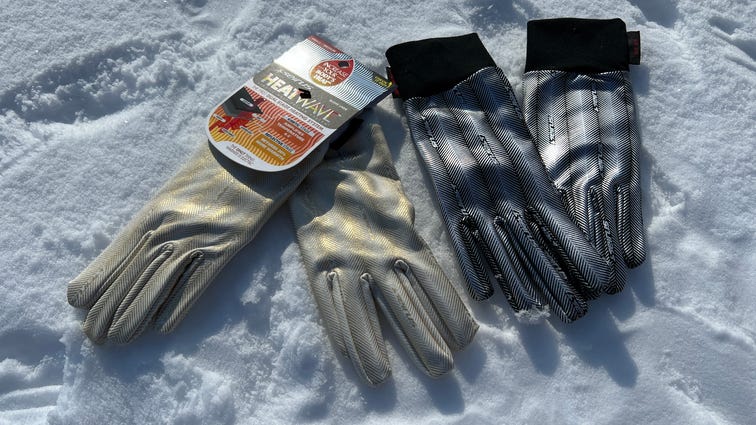

David Carnoy/CNET
These glove liners are equipped with Seirus’ Kinetic heat return system that it says amplifies your body heat 4 to 5 degrees and reflects it back to you for 20% more warmth. Of course, how warm your hands are will also depend on how warm the gloves are that go over these (they can be used as stand-alone gloves, but more for running in cold weather than skiing).

 \n ","topic":"","ttag":"","variant":"","viewguid":"","event":"listicle|image|11","correlationId":"","_destCat":"https:\/\/www.therabody.com\/us\/en-us\/mini-us.html","productName":"Theragun Mini massage gun","formatType":"IMAGE","location":"LIST","position":11,"sku":"","dwLinkTag":"article-body|listicle|image","selector":"#article-body #listicle-ed015d92-2b13-4506-849e-d3dc6a80ce88 .itemImage"}}” rel=”noopener nofollow” target=”_blank”>
\n ","topic":"","ttag":"","variant":"","viewguid":"","event":"listicle|image|11","correlationId":"","_destCat":"https:\/\/www.therabody.com\/us\/en-us\/mini-us.html","productName":"Theragun Mini massage gun","formatType":"IMAGE","location":"LIST","position":11,"sku":"","dwLinkTag":"article-body|listicle|image","selector":"#article-body #listicle-ed015d92-2b13-4506-849e-d3dc6a80ce88 .itemImage"}}” rel=”noopener nofollow” target=”_blank”>


David Carnoy/CNET
After a day of shredding, your body will certainly appreciate a little percussion massage gun action. There are plenty of options available but we like the travel-friendly Theragun Mini because it won’t weigh your luggage down too much and is a great little massage gun for $199 that’s surprisingly powerful for its size.
Like the other new Theragun models, the Mini is equipped with Quiet Force technology that allows the device to run just as powerfully but much more quietly than the previous generation of Theraguns. The Theragun Mini has three speed settings, ranging from 1,750 rpm to 2,400 rpm, and the battery lasts for 150 minutes of continuous use.
The one notable downside to the Theragun Mini is that it only comes with one attachment, the standard ball head. You could buy other Theragun attachments a la carte because the Mini is compatible with all the same attachments that come with other models, but that brings the price up.

 \n ","topic":"","ttag":"","variant":"","viewguid":"","event":"listicle|image|12","correlationId":"","_destCat":"https:\/\/getcarv.com\/","productName":"Carv Digital Ski Instructor","formatType":"IMAGE","location":"LIST","position":12,"sku":"","dwLinkTag":"article-body|listicle|image","selector":"#article-body #listicle-6cdd0a12-808e-4d6b-903b-2dd9c694ea40 .itemImage"}}” rel=”noopener nofollow” target=”_blank”>
\n ","topic":"","ttag":"","variant":"","viewguid":"","event":"listicle|image|12","correlationId":"","_destCat":"https:\/\/getcarv.com\/","productName":"Carv Digital Ski Instructor","formatType":"IMAGE","location":"LIST","position":12,"sku":"","dwLinkTag":"article-body|listicle|image","selector":"#article-body #listicle-6cdd0a12-808e-4d6b-903b-2dd9c694ea40 .itemImage"}}” rel=”noopener nofollow” target=”_blank”>
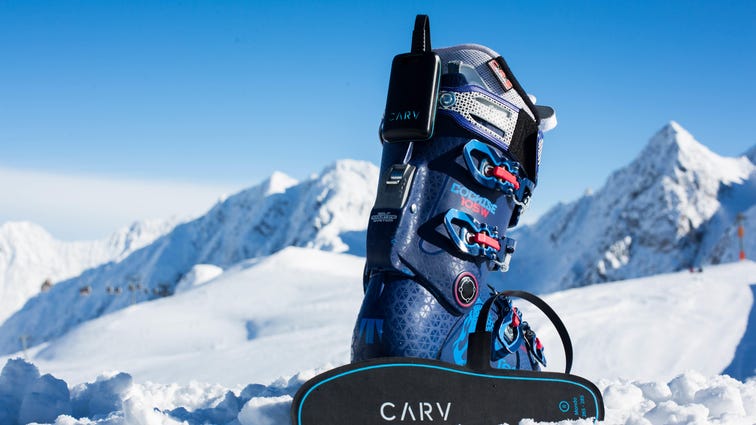

Florian Breitenberger
Private lessons have gotten really expensive, so why not get a virtual one?
Carv is a digital ski coach that combines some hardware that you attach to your boots with an iOS app (Android coming soon) that delivers real-time feedback about how you’re skiing.
I’m still waiting to try this out but initial reviews have been positive and the software has recently been updated to version 2.0 with some small hardware enhancements, including a more compact battery with the same battery life.
The Carv kit lists for $349. That’s a lot less than what a single full-day private lesson would cost you at most resorts — at least in the US.

 \n ","topic":"","ttag":"","variant":"","viewguid":"","event":"listicle|image|13","correlationId":"","_destCat":"https:\/\/www.shopglade.com\/products\/photochromic-ski-goggles?avad=262561_b26097871","productName":"Glade Adapt goggles with photochromic lens","formatType":"IMAGE","location":"LIST","position":13,"sku":"","dwLinkTag":"article-body|listicle|image","selector":"#article-body #listicle-bc08f434-d321-444f-906c-e742422391b5 .itemImage"}}” rel=”noopener nofollow” target=”_blank”>
\n ","topic":"","ttag":"","variant":"","viewguid":"","event":"listicle|image|13","correlationId":"","_destCat":"https:\/\/www.shopglade.com\/products\/photochromic-ski-goggles?avad=262561_b26097871","productName":"Glade Adapt goggles with photochromic lens","formatType":"IMAGE","location":"LIST","position":13,"sku":"","dwLinkTag":"article-body|listicle|image","selector":"#article-body #listicle-bc08f434-d321-444f-906c-e742422391b5 .itemImage"}}” rel=”noopener nofollow” target=”_blank”>
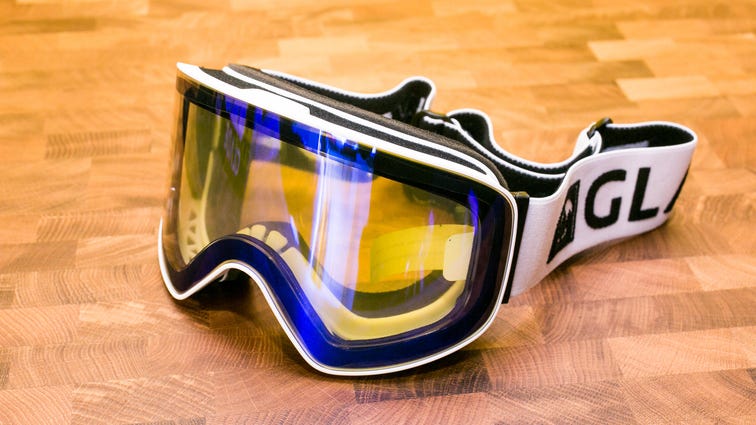

Sarah Tew/CNET
If you don’t want to pay upward of $200 for a set of Smith I/O goggles, there are plenty of more affordable alternatives, including those from Colorado-based Glade, which prides itself on making goggles that offer similar or better performance than high-end models from other companies for a lot less.
The big deal is its Adapt goggles include a Photochromatic Flux lens for $129. This is a lens that changes colors according to the lighting conditions you experience. In other words, it’s the chameleon of lenses, and typically photochromatic goggles cost a lot more.

 \n ","topic":"","ttag":"","variant":"","viewguid":"","event":"listicle|image|14","correlationId":"","_destCat":"https:\/\/www.smithoptics.com\/en_US\/goggles\/M007322QJ99XP.html","productName":"Smith 4D MAG","formatType":"IMAGE","location":"LIST","position":14,"sku":"","dwLinkTag":"article-body|listicle|image","selector":"#article-body #listicle-e2c516db-88d1-4080-968b-821369d4db38 .itemImage"}}” rel=”noopener nofollow” target=”_blank”>
\n ","topic":"","ttag":"","variant":"","viewguid":"","event":"listicle|image|14","correlationId":"","_destCat":"https:\/\/www.smithoptics.com\/en_US\/goggles\/M007322QJ99XP.html","productName":"Smith 4D MAG","formatType":"IMAGE","location":"LIST","position":14,"sku":"","dwLinkTag":"article-body|listicle|image","selector":"#article-body #listicle-e2c516db-88d1-4080-968b-821369d4db38 .itemImage"}}” rel=”noopener nofollow” target=”_blank”>
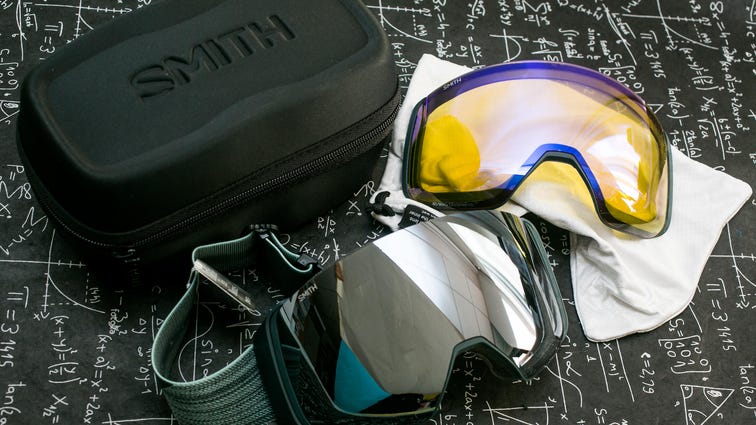

Sarah Tew/CNET
The Smith 4D MAG googles are the company’s current top-of-the-line model and have seen a price increase from $280 to $320. They feature a wider field of view (25% wider than the I/O Mag, according to Smith) and a 5x antifog inner lens with AirEvac Integration Technology that helps reduce fogging. Changing the lenses is easy with the MAG system. Two levers release the lens, which adheres magnetically to the goggles. One low-light and one bright-light lens are included.

 \n ","topic":"","ttag":"","variant":"","viewguid":"","event":"listicle|image|15","correlationId":"","_destCat":"https:\/\/www.smithoptics.com\/en_US\/goggles-snow\/M007132QJ996K.html","productName":"Smith I\/O MAG XL","formatType":"IMAGE","location":"LIST","position":15,"sku":"","dwLinkTag":"article-body|listicle|image","selector":"#article-body #listicle-3966175a-cad1-4677-9148-4aa8196e6d0d .itemImage"}}” rel=”noopener nofollow” target=”_blank”>
\n ","topic":"","ttag":"","variant":"","viewguid":"","event":"listicle|image|15","correlationId":"","_destCat":"https:\/\/www.smithoptics.com\/en_US\/goggles-snow\/M007132QJ996K.html","productName":"Smith I\/O MAG XL","formatType":"IMAGE","location":"LIST","position":15,"sku":"","dwLinkTag":"article-body|listicle|image","selector":"#article-body #listicle-3966175a-cad1-4677-9148-4aa8196e6d0d .itemImage"}}” rel=”noopener nofollow” target=”_blank”>


Sarah Tew/CNET
If you wear glasses, the $270 I/O MAG XL goggles are a good choice, albeit a fairly expensive one.
The MAG XL is Smith’s MAG lens change system featuring — you guessed it — magnets that let you easily swap out lenses, as well as a 5x antifog inner lens with AirEvac Integration Technology that helps reduce fogging. They come with two lenses.
The Smith I/O MAG XL goggles come in several different ChromoPop lens colors.

 \n ","topic":"","ttag":"","variant":"","viewguid":"","event":"listicle|image|16","correlationId":"","_destCat":"https:\/\/www.amazon.com\/Seirus-1083-Touch-Hellfire-Glove\/dp\/B075ZW4SYQ","productName":"Seirus HeatTouch Hellfire","formatType":"IMAGE","location":"LIST","position":16,"sku":"","dwLinkTag":"article-body|listicle|image","selector":"#article-body #listicle-13c78d3c-7a45-41a8-a99e-903a6f49911d .itemImage"}}” rel=”noopener nofollow” target=”_blank”>
\n ","topic":"","ttag":"","variant":"","viewguid":"","event":"listicle|image|16","correlationId":"","_destCat":"https:\/\/www.amazon.com\/Seirus-1083-Touch-Hellfire-Glove\/dp\/B075ZW4SYQ","productName":"Seirus HeatTouch Hellfire","formatType":"IMAGE","location":"LIST","position":16,"sku":"","dwLinkTag":"article-body|listicle|image","selector":"#article-body #listicle-13c78d3c-7a45-41a8-a99e-903a6f49911d .itemImage"}}” rel=”noopener nofollow” target=”_blank”>


Sarah Tew/CNET
Seirus’ flagship HeatTouch Hellfire gloves are available for $450 for men or women. The gloves haven’t changed for a few years, but the battery was upgraded last year to a more slimmed-down version with increased battery life.
At the low-heat setting you can get up to 12 hours of battery life, with medium pegged at around 8 hours and high at 4 hours.
It’s also available in a mitten for $425.

 \n ","topic":"","ttag":"","variant":"","viewguid":"","event":"listicle|image|17","correlationId":"","_destCat":"https:\/\/www.amazon.com\/Smith-Optics-Adult-Snowmobile-Helmet\/dp\/B0756MC3VB","productName":"Smith Code helmet","formatType":"IMAGE","location":"LIST","position":17,"sku":"","dwLinkTag":"article-body|listicle|image","selector":"#article-body #listicle-91afc3dd-c09d-46b2-adfd-7b39dcb99a52 .itemImage"}}” rel=”noopener nofollow” target=”_blank”>
\n ","topic":"","ttag":"","variant":"","viewguid":"","event":"listicle|image|17","correlationId":"","_destCat":"https:\/\/www.amazon.com\/Smith-Optics-Adult-Snowmobile-Helmet\/dp\/B0756MC3VB","productName":"Smith Code helmet","formatType":"IMAGE","location":"LIST","position":17,"sku":"","dwLinkTag":"article-body|listicle|image","selector":"#article-body #listicle-91afc3dd-c09d-46b2-adfd-7b39dcb99a52 .itemImage"}}” rel=”noopener nofollow” target=”_blank”>
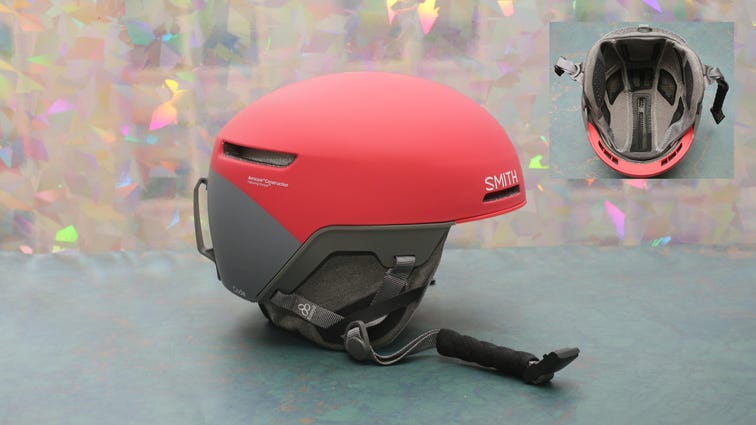

Sarah Tew/CNET
In the past, I’ve highlighted Smith’s Vantage helmet, which has a visor. The Code is more oriented toward snowboarders and free riders, but a lot of mainstream skiers like its streamlined look.
Smith didn’t change anything in this year’s model from last year’s — except for the color options. It packs in most of Smith’s latest technologies (they’re in the Vantage as well). On the inside, instead of hard foam you’ll find Koroyd inserts that, from the top, look like a honeycomb with circular (not hexagonal) cylinders. The high-tech material is made of lightweight, eco-friendly polymer extruded tubes that are thermally welded together to form a strong layer of protection that also allows for good airflow. (Smith has added other materials and design elements to the helmet and is calling the whole protection package Aerocore construction.)
Beyond the fancy padding, there’s the BOA FS360 fit system (with a 360-degree halo design), which helps you get a snug, “custom” fit. And new this year: a Wayfinder strap system featuring Fidlock that’s basically a quick-release magnetic system that makes it easier to open and close the strap.
The helmet only comes in a MIPS version, which offers increased protection. In a MIPS Brain Protection System, the shell and liner are separated by a low-friction layer that “allows the helmet to slide relative to the head.”

 \n ","topic":"","ttag":"","variant":"","viewguid":"","event":"listicle|image|18","correlationId":"","_destCat":"https:\/\/www.amazon.com\/Giro-Jackson-MIPS-Snow-Helmet\/dp\/B07RVPYGJW","productName":"Giro Jackson","formatType":"IMAGE","location":"LIST","position":18,"sku":"","dwLinkTag":"article-body|listicle|image","selector":"#article-body #listicle-07b67146-d7a5-4a86-9d87-40945009d317 .itemImage"}}” rel=”noopener nofollow” target=”_blank”>
\n ","topic":"","ttag":"","variant":"","viewguid":"","event":"listicle|image|18","correlationId":"","_destCat":"https:\/\/www.amazon.com\/Giro-Jackson-MIPS-Snow-Helmet\/dp\/B07RVPYGJW","productName":"Giro Jackson","formatType":"IMAGE","location":"LIST","position":18,"sku":"","dwLinkTag":"article-body|listicle|image","selector":"#article-body #listicle-07b67146-d7a5-4a86-9d87-40945009d317 .itemImage"}}” rel=”noopener nofollow” target=”_blank”>


David Carnoy/CNET
Giro’s says the “modern profile” of its Jackson helmet, which comes in multiple color options, utilizes the new Passive Aggressive Venting system that’s “inspired by the aerodynamic airflow of high-end autos.” Well, it’s a good looking helmet and also pretty lightweight and comfortable while offering MIPS (Multi-directional Impact Protection) technology.
It doesn’t have the company’s upgraded Spherical MIPS technology found in its Emerge helmet ($150), this model has Giro’s Form 2 Fit system that allows you to dial in the fit of the helmet (its similar to Smith’s dial-in fit), which allowed me to get a snugger fit. The Emerge uses the company’s Stash Fit system that allows you to remove or add layers of padding to customize your fit.
Both the Emerge and the Jackson are designed for maximum compatibility with Giro goggles but they work just fine with other goggles.

 \n ","topic":"","ttag":"","variant":"","viewguid":"","event":"listicle|image|19","correlationId":"","_destCat":"https:\/\/www.backcountry.com\/giro-method-goggles?CMP_SKU=GIR00LX&MER","productName":"Giro Method goggles","formatType":"IMAGE","location":"LIST","position":19,"sku":"","dwLinkTag":"article-body|listicle|image","selector":"#article-body #listicle-56dc1ddb-8863-43d3-918e-992516c48ba5 .itemImage"}}” rel=”noopener nofollow” target=”_blank”>
\n ","topic":"","ttag":"","variant":"","viewguid":"","event":"listicle|image|19","correlationId":"","_destCat":"https:\/\/www.backcountry.com\/giro-method-goggles?CMP_SKU=GIR00LX&MER","productName":"Giro Method goggles","formatType":"IMAGE","location":"LIST","position":19,"sku":"","dwLinkTag":"article-body|listicle|image","selector":"#article-body #listicle-56dc1ddb-8863-43d3-918e-992516c48ba5 .itemImage"}}” rel=”noopener nofollow” target=”_blank”>


David Carnoy/CNET
Giro makes a couple of goggles in the $150 range, including the Method and Article. It describes the Method as having a “bold retro style” that’s been advanced with “the most modern technology.” It’s a comfortable goggle with a wide field of view and good venting that helps keep the goggles fog-free in most conditions (I haven’t met a goggle that’s truly fog-free in all conditions).
Like the more rounded Article goggles ($170), the Method uses Giro’s VIVID lens with optics by Zeiss and a second lens is included. The Method is available in a few different color options.

 \n ","topic":"","ttag":"","variant":"","viewguid":"","event":"listicle|image|20","correlationId":"","_destCat":"https:\/\/www.amazon.com\/SPY-Square-Sunglasses-Contrast-Enhancing\/dp\/B094R3FNL2\/","productName":"Spy Helm Tech","formatType":"IMAGE","location":"LIST","position":20,"sku":"","dwLinkTag":"article-body|listicle|image","selector":"#article-body #listicle-1a006119-e5ff-4366-ad2e-ca0aa800c4ba .itemImage"}}” rel=”noopener nofollow” target=”_blank”>
\n ","topic":"","ttag":"","variant":"","viewguid":"","event":"listicle|image|20","correlationId":"","_destCat":"https:\/\/www.amazon.com\/SPY-Square-Sunglasses-Contrast-Enhancing\/dp\/B094R3FNL2\/","productName":"Spy Helm Tech","formatType":"IMAGE","location":"LIST","position":20,"sku":"","dwLinkTag":"article-body|listicle|image","selector":"#article-body #listicle-1a006119-e5ff-4366-ad2e-ca0aa800c4ba .itemImage"}}” rel=”noopener nofollow” target=”_blank”>
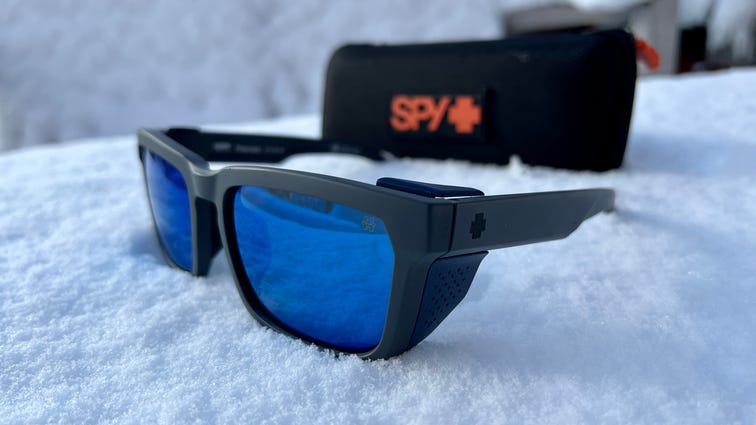

David Carnoy/CNET
Constructed from Grilamid, a lightweight but very durable frame material, the Spy Helm Tech sunglasses are a modern take on glacier sunglasses that includes removable side shields so you can block both the sun and all the “haters” at the same time, according to the company (they turn into standard wayfarer sunglasses without the side shields).
The sunglasses have hidden sweat channels in both the nose pads and inner temples for breathability and feature the company’s Happy Tech lens tech that it says is “scientifically tuned to boost mood and alertness while enhancing color and contrast.”
True or not, I will say they fit comfortably, the optics were very good and I was indeed happy using them.

 \n ","topic":"","ttag":"","variant":"","viewguid":"","event":"listicle|image|21","correlationId":"","_destCat":"https:\/\/www.lifeproof.com\/en-us\/fre-case-for-magsafe-for-iphone-13-pro\/fre-magsafe-iphp21.html","productName":"Lifeproof Fre with MagSafe","formatType":"IMAGE","location":"LIST","position":21,"sku":"","dwLinkTag":"article-body|listicle|image","selector":"#article-body #listicle-00829b9d-a00a-478e-ba07-829d2823d860 .itemImage"}}” rel=”noopener nofollow” target=”_blank”>
\n ","topic":"","ttag":"","variant":"","viewguid":"","event":"listicle|image|21","correlationId":"","_destCat":"https:\/\/www.lifeproof.com\/en-us\/fre-case-for-magsafe-for-iphone-13-pro\/fre-magsafe-iphp21.html","productName":"Lifeproof Fre with MagSafe","formatType":"IMAGE","location":"LIST","position":21,"sku":"","dwLinkTag":"article-body|listicle|image","selector":"#article-body #listicle-00829b9d-a00a-478e-ba07-829d2823d860 .itemImage"}}” rel=”noopener nofollow” target=”_blank”>


David Carnoy/CNET
Most new phones, including the iPhone 13 models, offer a decent level of water resistance. But if you want some added protection, Lifeproof still sells its waterproof and shockproof Fre case — and the latest version is built for MagSafe accessories.
The Fre case is also available for some Samsung Galaxy models but that version doesn’t feature MagSafe, a feature that adds $10 to the case.

 \n ","topic":"","ttag":"","variant":"","viewguid":"","event":"listicle|image|22","correlationId":"","_destCat":"https:\/\/www.amazon.com\/dp\/B09B8ZG8KY","productName":"MyCharge Superhero Mag-Lock","formatType":"IMAGE","location":"LIST","position":22,"sku":"","dwLinkTag":"article-body|listicle|image","selector":"#article-body #listicle-e29e462e-1dd7-4dcd-86e8-e1acc6c4a8e0 .itemImage"}}” rel=”noopener nofollow” target=”_blank”>
\n ","topic":"","ttag":"","variant":"","viewguid":"","event":"listicle|image|22","correlationId":"","_destCat":"https:\/\/www.amazon.com\/dp\/B09B8ZG8KY","productName":"MyCharge Superhero Mag-Lock","formatType":"IMAGE","location":"LIST","position":22,"sku":"","dwLinkTag":"article-body|listicle|image","selector":"#article-body #listicle-e29e462e-1dd7-4dcd-86e8-e1acc6c4a8e0 .itemImage"}}” rel=”noopener nofollow” target=”_blank”>
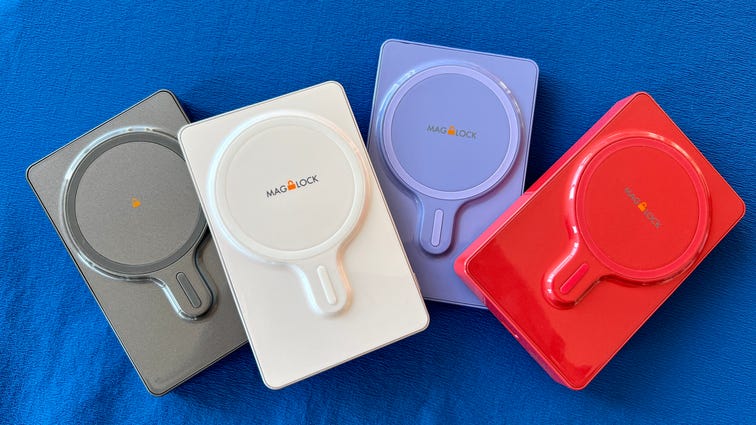

David Carnoy/CNET
You don’t want your phone to go dead on the mountain, so it’s always good to pack a battery pack.
MyCharge calls its new line of magnetic power banks Superhero Mag-Lock, implying that they’re real saviors. I was impressed by their design. Not only do the batteries, which come in various capacities, have strong magnets and stick really well to the back of your iPhone 12 or 13, but they have raised coils, which are supposed to help with reducing heat levels while charging. It does seem to work.
The 3,000-mAh battery is lightweight and slim and is nice to have around for some emergency charging. However, it won’t get you a full charge, so you’ll probably want to step up to one of the higher-capacity options like the 6,000-mAh model that retails for $60 but is currently being discounted to $40. The 9,000-mAh version is beefy and feels like your phone is attached to a small brick (the battery and phone do fit in your hand nicely but the combo certainly isn’t pocket-friendly).
All the Mag-Lock batteries charge Qi-enabled iPhones at 5W, although you can get faster charging if you go wired and use a USB-C to Lightning cable. I also liked how there’s a chime when the charging starts and your phone tells you how much juice is left in the battery pack (it’s tied into iOS 15). You can wirelessly charge Android devices as well, but the Mag-Lock won’t stick unless you have a metal ring on back of your phone’s case. Stick-on rings are available for sale.
The MyCharge SuperHero Mag-Lock is available in a few color options and has a nice glossy finish. It currently is the best-designed magnetic power bank — better even than Apple’s.

 \n ","topic":"","ttag":"","variant":"","viewguid":"","event":"listicle|image|23","correlationId":"","_destCat":"https:\/\/www.amazon.com\/Anker-PowerCore-10000mAh-Portable-Delivery\/dp\/B07YZ4FFNZ","productName":"Biolite Charge Series","formatType":"IMAGE","location":"LIST","position":23,"sku":"","dwLinkTag":"article-body|listicle|image","selector":"#article-body #listicle-ba80d41f-c0df-45e6-830b-865860e046e0 .itemImage"}}” rel=”noopener nofollow” target=”_blank”>
\n ","topic":"","ttag":"","variant":"","viewguid":"","event":"listicle|image|23","correlationId":"","_destCat":"https:\/\/www.amazon.com\/Anker-PowerCore-10000mAh-Portable-Delivery\/dp\/B07YZ4FFNZ","productName":"Biolite Charge Series","formatType":"IMAGE","location":"LIST","position":23,"sku":"","dwLinkTag":"article-body|listicle|image","selector":"#article-body #listicle-ba80d41f-c0df-45e6-830b-865860e046e0 .itemImage"}}” rel=”noopener nofollow” target=”_blank”>


Amazon
Biolite has a new line of portable batteries that offer USB-C PD fast-charging (up to 18W) along with two additional USB-A ports so you can charge a couple of phones at the same time, albeit at slower speeds. There are three sizes available — 6,000-mAh, 10,000-mAh and 20,000-mAh — but 6,000-mAh version (pictured on right) is probably best for skiers because it’s slim, relatively lightweight and fits easily in a pocket. To charge iPhones at 18W speeds, you’ll need to bring your own USB-C to Lightning cable to the charging party (the latest iPhones include that cable).
Although Biolite says its powerbanks are “durable,” they don’t have a water-resistance rating. That said, they should survive a drop in the snow just fine.

 \n ","topic":"","ttag":"","variant":"","viewguid":"","event":"listicle|image|24","correlationId":"","_destCat":"https:\/\/www.zealoptics.com\/US\/en_US\/shop\/goggles","productName":"Zeal Optics goggles","formatType":"IMAGE","location":"LIST","position":24,"sku":"","dwLinkTag":"article-body|listicle|image","selector":"#article-body #listicle-f17852da-9bb9-4c37-8ea1-11aa301b12f5 .itemImage"}}” rel=”noopener nofollow” target=”_blank”>
\n ","topic":"","ttag":"","variant":"","viewguid":"","event":"listicle|image|24","correlationId":"","_destCat":"https:\/\/www.zealoptics.com\/US\/en_US\/shop\/goggles","productName":"Zeal Optics goggles","formatType":"IMAGE","location":"LIST","position":24,"sku":"","dwLinkTag":"article-body|listicle|image","selector":"#article-body #listicle-f17852da-9bb9-4c37-8ea1-11aa301b12f5 .itemImage"}}” rel=”noopener nofollow” target=”_blank”>
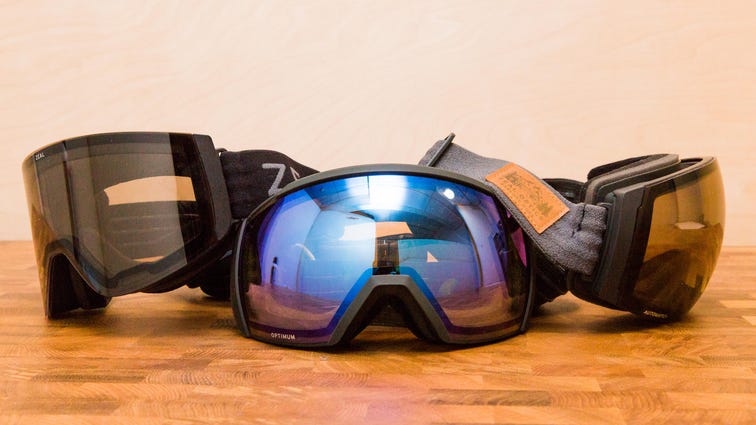

Sarah Tew/CNET
Zeal goggles have excellent optics and a wide field of view, and many feature the company’s Rail Lock System that makes the lenses easy to change and the goggles easy to vent when you’re in hiking mode.
The base models with standard lenses are pretty affordable, ranging from $129 to $159. Things get more expensive when you move to the Automatic Plus GB lens, which is photochromic and changes quickly with the lighting and works in any conditions. Add that Automatic Plus lens and the price goes up to $279.
A lot of people like the Hatchet (on the left in the photo above), which is available for around $150 with the Optimum lens (nonphotochromic) of your choice along with a Sky Blue Mirror lens.
I like the Portal XL (on right), which also starts at $179 for the standard two-lens option. It has the widest field of view and is an OTG type that allows you to wear glasses.
The Hemisphere, starting at $130, has a spherical frame with upper and lower ventilation and triple-layer face foam and is available in a variety of lens options. It doesn’t have the RLS system, but the lens quality is quite good for the price.

 \n ","topic":"","ttag":"","variant":"","viewguid":"","event":"listicle|image|25","correlationId":"","_destCat":"https:\/\/www.amazon.com\/Jaybird-Wireless-Bluetooth-Headphones-Charging\/dp\/B08B3G74MY","productName":"Jaybird Vista 2","formatType":"IMAGE","location":"LIST","position":25,"sku":"","dwLinkTag":"article-body|listicle|image","selector":"#article-body #listicle-abdfd976-0949-4fc9-9473-67e4124a27d4 .itemImage"}}” rel=”noopener nofollow” target=”_blank”>
\n ","topic":"","ttag":"","variant":"","viewguid":"","event":"listicle|image|25","correlationId":"","_destCat":"https:\/\/www.amazon.com\/Jaybird-Wireless-Bluetooth-Headphones-Charging\/dp\/B08B3G74MY","productName":"Jaybird Vista 2","formatType":"IMAGE","location":"LIST","position":25,"sku":"","dwLinkTag":"article-body|listicle|image","selector":"#article-body #listicle-abdfd976-0949-4fc9-9473-67e4124a27d4 .itemImage"}}” rel=”noopener nofollow” target=”_blank”>
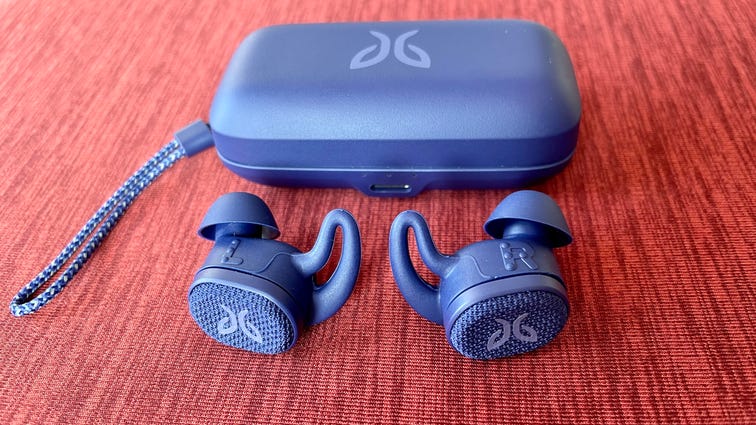

David Carnoy/CNET
The Jaybird Vista 2 sports buds feature a similar design to the original Vista buds but have a couple of key upgrades: active noise canceling and a transparency mode called SurroundSense that allows you to hear the outside world, an important safety feature for skiers as well as runners and bikers.
The Vista 2 buds have an IPX68 water resistance rating, which means they’re both dust-proof and fully waterproof. Jaybird says they’re also sweat-proof, crush-proof and drop-proof. And the compact case is now splash-proof and dust-resistant, with an IP54 rating.
They sound quite good once you tweak the EQ settings to your liking, but in sound quality they’re not quite up to the level of some other premium earbuds. Their noise-canceling, transparency mode and voice calling are decent though unspectacular (the Beats Fit Pro perform better in all departments). But if you’re buying these, you’re buying them for the secure fit and durability.

 \n ","topic":"","ttag":"","variant":"","viewguid":"","event":"listicle|image|26","correlationId":"","_destCat":"https:\/\/www.amazon.com\/Smith-Wildcat-Chromapop-Sunglasses-Black\/dp\/B084GFRFP2","productName":"Smith Wildcat sunglasses","formatType":"IMAGE","location":"LIST","position":26,"sku":"","dwLinkTag":"article-body|listicle|image","selector":"#article-body #listicle-e1da0e4f-de3c-4644-9521-8218ce1917bc .itemImage"}}” rel=”noopener nofollow” target=”_blank”>
\n ","topic":"","ttag":"","variant":"","viewguid":"","event":"listicle|image|26","correlationId":"","_destCat":"https:\/\/www.amazon.com\/Smith-Wildcat-Chromapop-Sunglasses-Black\/dp\/B084GFRFP2","productName":"Smith Wildcat sunglasses","formatType":"IMAGE","location":"LIST","position":26,"sku":"","dwLinkTag":"article-body|listicle|image","selector":"#article-body #listicle-e1da0e4f-de3c-4644-9521-8218ce1917bc .itemImage"}}” rel=”noopener nofollow” target=”_blank”>
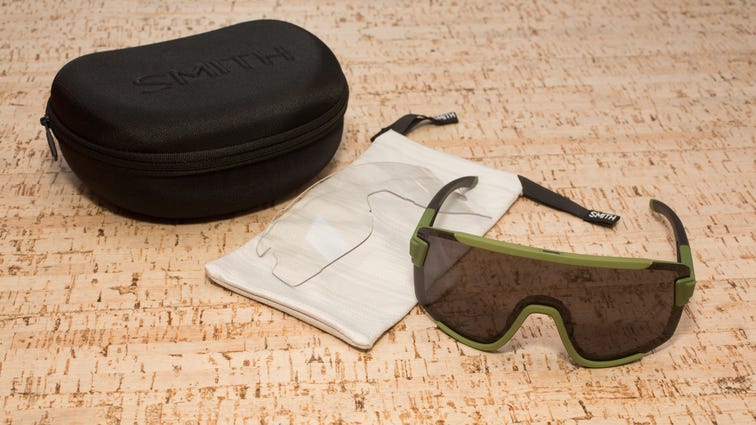

Sarah Tew/CNET
This is Smith’s goggles-sunglasses hybrid, the Wildcat ($200). Constructed with the same materials used in Smith goggles, the Wildcat glasses provide lots of eye coverage and good airflow but have the comfort of a more lightweight pair of sunglasses. The Wildcat sunglasses comes with a bright-light ChromaPop lens and a secondary clear lens for flat-light overcast days and are available in three color options.

 \n ","topic":"","ttag":"","variant":"","viewguid":"","event":"listicle|image|27","correlationId":"","_destCat":"https:\/\/www.amazon.com\/dp\/B091TXRFJF","productName":"USWE Flow 16L backpack","formatType":"IMAGE","location":"LIST","position":27,"sku":"","dwLinkTag":"article-body|listicle|image","selector":"#article-body #listicle-79ab84b2-a153-4746-857b-1cfe5b8fe5f0 .itemImage"}}” rel=”noopener nofollow” target=”_blank”>
\n ","topic":"","ttag":"","variant":"","viewguid":"","event":"listicle|image|27","correlationId":"","_destCat":"https:\/\/www.amazon.com\/dp\/B091TXRFJF","productName":"USWE Flow 16L backpack","formatType":"IMAGE","location":"LIST","position":27,"sku":"","dwLinkTag":"article-body|listicle|image","selector":"#article-body #listicle-79ab84b2-a153-4746-857b-1cfe5b8fe5f0 .itemImage"}}” rel=”noopener nofollow” target=”_blank”>


Amazon
This product comes at the recommendation of CNET editor Justin Jaffe, who lives in New England. He writes:
“As Covid surged again this winter, I’ve taken up alpine touring: skinning up a mountain and skiing down. The benefits are considerable — you can often get by without a lift pass and it delivers a much more rewarding cardio workout than pure downhill skiing. This highly adjustable USWE backpack has become an essential tool for me, providing the right amount of space for gear as well as an insulated water bladder that has never once frozen up. And there is a strap and pocket for everything, from goggles to helmet to skis. Highly recommended.”

 \n ","topic":"","ttag":"","variant":"","viewguid":"","event":"listicle|image|28","correlationId":"","_destCat":"https:\/\/www.amazon.com\/Outdoor-Universal-Bluetooth-Walkie-Talkie-OT0052\/dp\/B01KZSRB1W","productName":"Outdoor Technology Chips 2.0","formatType":"IMAGE","location":"LIST","position":28,"sku":"","dwLinkTag":"article-body|listicle|image","selector":"#article-body #listicle-2872c3fc-b1ab-4aa8-8098-1afe20640957 .itemImage"}}” rel=”noopener nofollow” target=”_blank”>
\n ","topic":"","ttag":"","variant":"","viewguid":"","event":"listicle|image|28","correlationId":"","_destCat":"https:\/\/www.amazon.com\/Outdoor-Universal-Bluetooth-Walkie-Talkie-OT0052\/dp\/B01KZSRB1W","productName":"Outdoor Technology Chips 2.0","formatType":"IMAGE","location":"LIST","position":28,"sku":"","dwLinkTag":"article-body|listicle|image","selector":"#article-body #listicle-2872c3fc-b1ab-4aa8-8098-1afe20640957 .itemImage"}}” rel=”noopener nofollow” target=”_blank”>


Sarah Tew/CNET
You’d think that more companies would have made Bluetooth headphones that slip inside your helmet, but Outdoor Technology is one of the few that does (some Chinese companies like Outdoor Master have gotten in on the game in the last couple of years). Their appeal has waned now that true wireless earbuds have come along, but they’re still available at a discounted price, around $90.
How it works is you charge up the Chips and slide them into the earflaps on your helmet (they should work with most helmets). You want to make sure that no excess padding in your helmet is covering the Chips or else they’ll get muffled and you’ll lose some volume; you want them as close to your ears as possible.
The Chips 2.0 have a walkie-talkie feature that allows you to communicate with friends who are also using Chips 2.0 headphones. You create a group using the ODT Walkie-Talkie app and talk over the cell network, which means the only limit on distance is whether you’re getting a phone signal. Up to 99 people can be in your private group.
I thought the sound quality was decent for Bluetooth but not great. That said, it’s nice to be able to stick your helmet on and have the headphones built in with no wires to worry about. Battery life is rated at 10 hours, and the Chips are sweat- and water-resistant but not waterproof.
Outdoor Technology also sells the Chips Ultra, a true-wireless version of the Chips that costs significantly more (about $165). I don’t think the Ultras are worth the money.

 \n ","topic":"","ttag":"","variant":"","viewguid":"","event":"listicle|image|29","correlationId":"","_destCat":"https:\/\/www.amazon.com\/Non-Locking-Carabiner-Rotating-Hook-Clip\/dp\/B073PJKNVW","productName":"Heroclip","formatType":"IMAGE","location":"LIST","position":29,"sku":"","dwLinkTag":"article-body|listicle|image","selector":"#article-body #listicle-5705c8df-2464-46d3-8c49-6acfb1934bbf .itemImage"}}” rel=”noopener nofollow” target=”_blank”>
\n ","topic":"","ttag":"","variant":"","viewguid":"","event":"listicle|image|29","correlationId":"","_destCat":"https:\/\/www.amazon.com\/Non-Locking-Carabiner-Rotating-Hook-Clip\/dp\/B073PJKNVW","productName":"Heroclip","formatType":"IMAGE","location":"LIST","position":29,"sku":"","dwLinkTag":"article-body|listicle|image","selector":"#article-body #listicle-5705c8df-2464-46d3-8c49-6acfb1934bbf .itemImage"}}” rel=”noopener nofollow” target=”_blank”>


David Carnoy/CNET
You never know when you might need to hang up some gear, which is where the Heroclip comes in. Available in a few different sizes and colors, this souped-up rotating carabiner hook clip costs around $23.

 \n ","topic":"","ttag":"","variant":"","viewguid":"","event":"listicle|image|30","correlationId":"","_destCat":"https:\/\/www.amazon.com\/Two-Way-Global-Satellite-Communicator-Device\/dp\/B093R9VPMF","productName":"Bivy Stick","formatType":"IMAGE","location":"LIST","position":30,"sku":"","dwLinkTag":"article-body|listicle|image","selector":"#article-body #listicle-3c56875b-0096-4055-a0d6-28e75438d933 .itemImage"}}” rel=”noopener nofollow” target=”_blank”>
\n ","topic":"","ttag":"","variant":"","viewguid":"","event":"listicle|image|30","correlationId":"","_destCat":"https:\/\/www.amazon.com\/Two-Way-Global-Satellite-Communicator-Device\/dp\/B093R9VPMF","productName":"Bivy Stick","formatType":"IMAGE","location":"LIST","position":30,"sku":"","dwLinkTag":"article-body|listicle|image","selector":"#article-body #listicle-3c56875b-0096-4055-a0d6-28e75438d933 .itemImage"}}” rel=”noopener nofollow” target=”_blank”>


Bivy
Satellite phones are not only expensive to buy but expensive to use. If you’re headed somewhere remote where there’s no cell service, a Bivy Stick is a relatively affordable way to send texts and share your location via satellite.
Once you buy the Bivy Stick ($200), you can activate it anytime for a month for $18, which includes 10 credits. One credit equals one message or one location share or one weather report or one hour of tracking.
If you use all 10 credits, you’ll be charged 50 cents per additional credit used. You can also buy additional credits beforehand and at a cheaper rate. Should you not use the credits over 30 days, they roll over to the next month if your account remains active. (You can turn off service at any time.)

 \n ","topic":"","ttag":"","variant":"","viewguid":"","event":"listicle|image|31","correlationId":"","_destCat":"https:\/\/www.amazon.com\/Black-Diamond-Guide-BT-Beacon\/dp\/B07F3FT1XV","productName":"Black Diamond Guide BT","formatType":"IMAGE","location":"LIST","position":31,"sku":"","dwLinkTag":"article-body|listicle|image","selector":"#article-body #listicle-0151ca81-2fe1-45d0-b997-1343442255a9 .itemImage"}}” rel=”noopener nofollow” target=”_blank”>
\n ","topic":"","ttag":"","variant":"","viewguid":"","event":"listicle|image|31","correlationId":"","_destCat":"https:\/\/www.amazon.com\/Black-Diamond-Guide-BT-Beacon\/dp\/B07F3FT1XV","productName":"Black Diamond Guide BT","formatType":"IMAGE","location":"LIST","position":31,"sku":"","dwLinkTag":"article-body|listicle|image","selector":"#article-body #listicle-0151ca81-2fe1-45d0-b997-1343442255a9 .itemImage"}}” rel=”noopener nofollow” target=”_blank”>


Andy Earl/Black Diamond
Black Diamond bills its Guide BT ($450) as the first avalanche beacon on the market to offer Bluetooth capabilities. That Bluetooth connection allows you to manage settings, software updates and battery optimization from your smartphone via the Pieps mobile app, while the housing features soft-touch contact points for improved handling.
From a core feature standpoint, it’s got a 60-meter circular range, mark and scan function for multiple burials, and an auto antenna switch that automatically adjusts to send the best signal. There’s also a self-check function for always-accurate antennas and Digital Signal Processing to account for wayward beacon signals. A harness-style carrying pouch is included.


